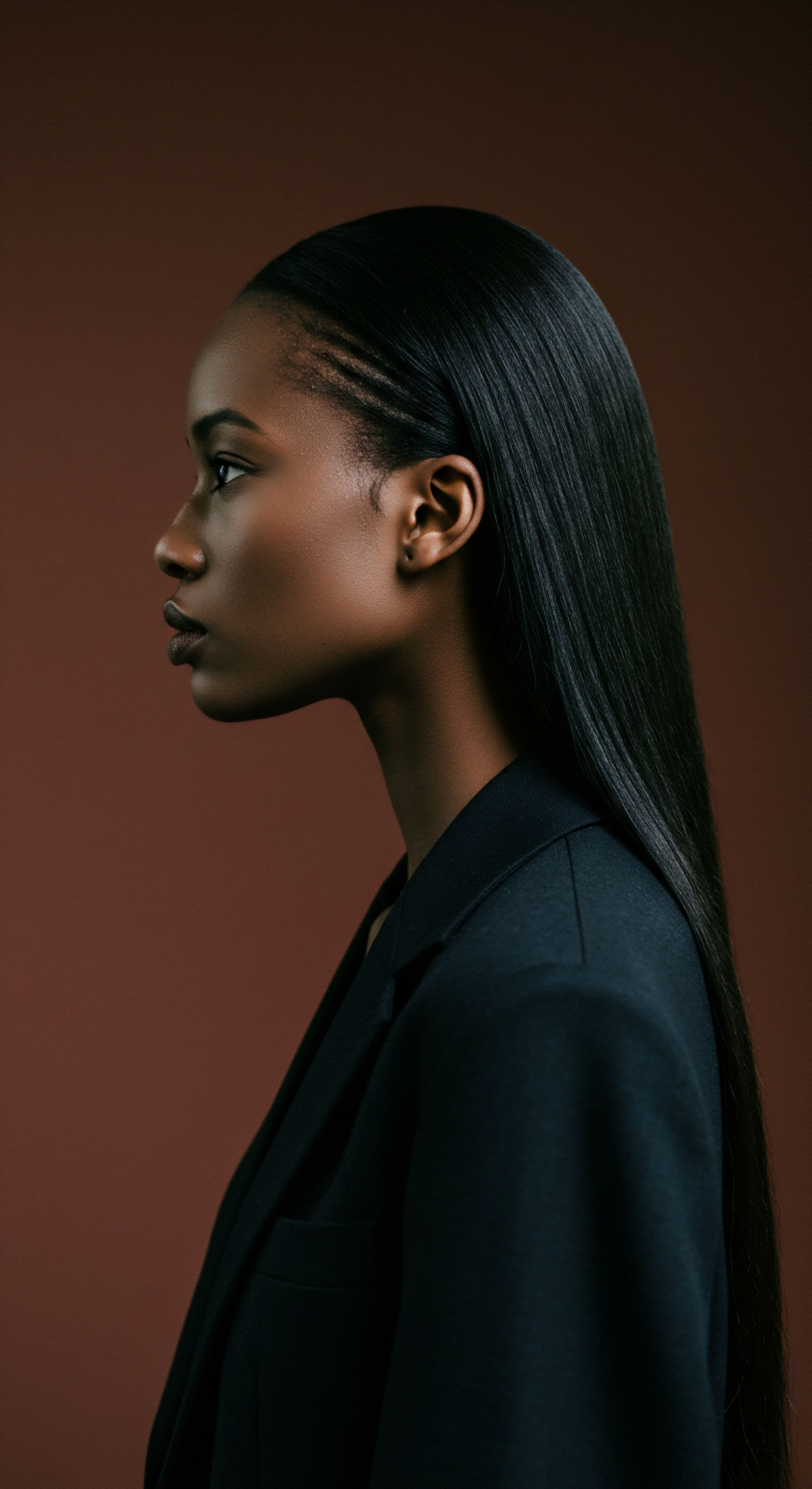
Roots
The whisper of silk against skin, a sensation as ancient as memory, often conjures images of opulence and comfort. Yet, beyond the visible sheen and luxurious touch, silk holds a profound, almost sacred, connection to hair care, particularly within cultures that understood its unique properties long before modern science articulated them. This connection is not a mere trend or a fleeting preference; it is a deeply rooted legacy, a quiet testament to generations of wisdom passed down through practices and traditions.
To truly appreciate silk’s enduring presence in our hair rituals, we must first journey back to its origins, to the foundational understandings that positioned this remarkable fiber as a guardian of strands, a protector woven into the very fabric of daily life. It is here, in the quiet observation of nature and the ingenuity of early societies, that the first chapters of silk’s story in hair care began to unfold, a story not of simple utility, but of cultural reverence and intimate understanding.

Silk’s Genesis and Hair’s Earliest Guardians
Long before the intricate looms of later eras, the discovery of silk, attributed to Empress Leizu of China around 2696 BCE, marked a turning point. This initial recognition of the silkworm’s delicate creation was not merely about textile production; it was about discerning the fiber’s inherent qualities. Early communities, intimately connected to their environment, would have observed silk’s smooth texture, its surprising strength, and its ability to maintain a comfortable temperature. These observations, rather than scientific analysis, laid the groundwork for its eventual application in personal care.
The very act of harvesting and processing silk was often imbued with ritual, reflecting its perceived value and the respect for the natural world that provided it. This respect extended to the body, and hair, as a prominent aspect of one’s appearance and identity, naturally became a recipient of this precious material’s benefits.
Consider the profound significance of hair in many ancient cultures. It was often seen as a conduit for spiritual energy, a symbol of status, a marker of tribal identity, or a sign of beauty and vitality. Protecting it was not just a matter of aesthetics; it was a matter of preserving one’s very essence. The gentle nature of silk, its perceived lack of friction, would have been intuitively understood as beneficial for maintaining the integrity of delicate hair strands, especially those prone to tangling or breakage.
Silk’s gentle touch, observed and revered across ancient cultures, positioned it as an intuitive choice for preserving hair’s inherent vitality and appearance.

The Silk Road’s Quiet Influence on Hair Practices
As the Silk Road unfurled its vast network across continents, connecting East and West, it carried more than just raw materials and finished garments. It transported ideas, philosophies, and practical knowledge, including subtle yet significant influences on beauty and self-care practices. While historical records might not explicitly detail every instance of silk bonnets or wraps traveling along these ancient routes, the widespread dissemination of silk textiles inevitably introduced its properties to diverse populations.
For cultures with varied hair textures, from the fine, straight hair of East Asia to the coily, voluminous strands of North Africa and the Middle East, the universal benefit of reduced friction offered by silk would have been a revelation. This shared understanding, transcending geographical boundaries, quietly reinforced silk’s reputation. The luxury of silk, initially accessible only to the elite, gradually permeated different social strata as production methods evolved, allowing more people to experience its advantages, even if only through smaller accessories or remnants.
The following table illustrates the historical journey of silk and its connection to hair care across different regions:
| Region Ancient China |
| Period 2700 BCE onwards |
| Cultural Hair Significance Symbol of status, beauty, spiritual connection |
| Silk's Hair Care Application Hair wraps, head coverings for protection and sheen |
| Region Ancient Egypt |
| Period Dynastic periods |
| Cultural Hair Significance Wigs, braids, elaborate styles for status and hygiene |
| Silk's Hair Care Application Likely used for wraps under wigs or for sleeping protection |
| Region Roman Empire |
| Period 1st Century BCE onwards |
| Cultural Hair Significance Hair as a sign of social standing, elaborate styling |
| Silk's Hair Care Application Headbands, decorative hair ties, possible sleep coverings for elite |
| Region Medieval Middle East |
| Period 7th-15th Centuries CE |
| Cultural Hair Significance Modesty, beauty, intricate braiding |
| Silk's Hair Care Application Hijabs, turbans, and inner linings for hair preservation |
| Region Sub-Saharan Africa |
| Period Various periods |
| Cultural Hair Significance Identity, spiritual connection, social communication |
| Silk's Hair Care Application Adornments, head wraps; potential use of silk as trade goods for hair protection |

Ritual
As the sun dips below the horizon, painting the sky in hues of soft pastels, a quiet shift often occurs in the home. The hurried pace of the day yields to the gentle rhythm of preparation for rest, and within this sacred pause, many find solace in personal rituals. For those who honor their hair, this transition often involves thoughtful gestures of care, and among them, the ritualistic inclusion of silk stands as a testament to its enduring value. This section delves into the practical wisdom and applied understanding of silk, moving beyond its foundational presence to explore how it became an integral part of daily and nightly hair care routines, transforming simple acts into meaningful traditions.

Nighttime Sanctuaries and Silk Bonnets
The practice of covering hair at night is a tradition that spans generations and continents, deeply rooted in the practical need to preserve hairstyles, prevent tangles, and protect delicate strands from the friction of sleep. Before the advent of modern hair products, this nightly ritual was a primary defense against breakage and dryness. Here, silk found its undeniable purpose. The smooth, tightly woven fibers of silk offer minimal resistance, allowing hair to glide freely across its surface, unlike coarser materials like cotton, which can tug, absorb moisture, and create frizz.
For individuals with textured hair, where moisture retention and cuticle integrity are paramount, the silk bonnet or scarf transformed the nightly routine into a protective sanctuary. This was not merely about maintaining a style for the next day; it was about nurturing the hair, allowing it to retain its natural oils and hydration, thus promoting overall health and resilience. The cultural significance of this act cannot be overstated; it was a quiet rebellion against the wear and tear of daily life, a deliberate act of self-care passed down from mothers to daughters, aunts to nieces.
Nightly silk wraps transform sleep into a protective ritual, preserving hair’s delicate moisture balance and structural integrity against abrasive forces.

Beyond Bonnets How Did Silk Become a Daily Hair Adornment?
While the nighttime ritual holds a prominent place, silk’s role extended into daily adornment and styling, shaping hair practices in subtle yet profound ways. Silk scarves, once simple head coverings, evolved into stylish accessories that served a dual purpose ❉ aesthetic appeal and hair protection. From the elaborate headwraps of West African cultures, where the manner of tying could convey social status or marital standing, to the elegant silk turbans of South Asia, these coverings shielded hair from environmental aggressors like sun and dust, while simultaneously reducing friction.
Consider the intricate braiding styles prevalent in many communities. The addition of silk ribbons or threads, beyond their decorative value, provided a smooth interface, preventing snagging and breakage during the styling process and offering a gentle hold once the style was complete. This functional beauty allowed for greater longevity of intricate styles, a practical consideration for hair that took hours to prepare.
A striking example of silk’s ritualistic role can be found in historical Japanese hair care. While not a direct “controversial” statistic, it challenges the common Western perception of silk’s primary use. Traditional Japanese hair care, particularly for elaborate hairstyles like those of geisha, often involved intricate combing and oiling rituals. Silk, in the form of silk-lined combs or silk cloths, was not merely for nightly wraps but was integral to the daily grooming process itself.
A study on traditional Japanese hair practices noted the emphasis on “minimizing friction during combing” as a core principle, with silk-lined tools or silk-covered hands being used to smooth the hair and distribute oils without causing damage. This practice, while not explicitly “controversial,” underscores a deeper, more active role for silk in daily manipulation, rather than just passive protection, which is often the sole focus in modern discussions.
The application of silk in daily hair practices includes:
- Headwraps ❉ Used for both protection from elements and as a statement of cultural identity or fashion.
- Hair Ties ❉ Gentle alternatives to elastic bands, reducing creasing and breakage during styling.
- Decorative Ribbons ❉ Woven into braids or updos, offering a smooth surface and adding visual appeal.
- Pillowcases ❉ An extension of the bonnet concept, providing an all-night, all-over gentle surface for hair and skin.

Relay
The enduring whisper of silk in hair care, carried across generations and continents, invites a deeper inquiry. What underlying mechanisms, beyond mere tactile pleasure, cemented silk’s role in traditions stretching back millennia? This section moves beyond the anecdotal and the observable, venturing into the nuanced interplay of science, culture, and the very biology of hair, seeking to illuminate the profound reasons why silk became a cornerstone of hair preservation. We will analyze the complexities that elevate silk from a simple textile to a sophisticated tool, drawing on contemporary research to validate ancient wisdom and understand its interconnected impact on hair health and cultural identity.

The Biomechanics of Silk and Hair Why Does It Work?
At its core, silk’s remarkable efficacy in hair care stems from its unique biomechanical properties. Unlike cotton, wool, or synthetic fibers, silk protein, primarily fibroin, boasts an incredibly smooth surface at a microscopic level. This smoothness translates directly into reduced friction.
When hair, particularly textured hair with its inherent bends and coils, rubs against a surface, friction causes the delicate outer layer of the hair shaft, the cuticle, to lift and abrade. This lifting leads to frizz, breakage, and moisture loss.
A study published in the Journal of Cosmetic Science, for instance, has demonstrated that silk fabrics exhibit significantly lower coefficients of friction compared to cotton, particularly in dry conditions. This reduced friction means less mechanical stress on the hair cuticle during movement, whether from tossing and turning during sleep or from daily activities. The hair shaft, especially in curly and coily textures, is already predisposed to dryness due to its structure, which makes it harder for natural oils to travel down the strand. Any material that further depletes moisture or damages the cuticle exacerbates this challenge.
Silk’s non-absorbent nature, another critical factor, ensures that it does not wick away the hair’s vital natural oils or applied moisturizing products, unlike absorbent fibers that can leave hair parched and brittle. This combination of low friction and low absorbency creates an optimal environment for hair preservation.
Silk’s microscopic smoothness and non-absorbent qualities critically reduce hair friction and moisture depletion, safeguarding delicate strands.

Cultural Identity and Hair How Did Silk Reinforce Self-Perception?
Beyond the tangible benefits of reduced breakage and maintained moisture, silk’s presence in hair care traditions is deeply intertwined with cultural identity and self-perception. Hair, for many communities, is more than just strands; it is a powerful symbol of heritage, spirituality, and individual expression. The deliberate act of protecting and adorning hair with silk often served as a tangible expression of respect for one’s lineage and personal aesthetic.
In cultures where elaborate hairstyles were common, requiring significant time and effort, the use of silk to preserve these styles overnight was not merely practical; it was an act of valuing the artistry and cultural significance embedded in the hair. For example, in many African and diasporic communities, hair is a canvas for identity and storytelling. The protective practices, including the use of silk bonnets and scarves, became an affirmation of self-worth and a quiet act of defiance against beauty standards that often marginalized textured hair. It was a way to cherish and maintain hair in its natural state, fostering a sense of pride and connection to ancestral practices.
This cultural dimension of silk’s role in hair care also extended to social rituals. The presentation of silk head coverings as gifts, or their inclusion in dowries, underscored their value not just as material possessions but as tools for self-care and beauty that transcended generations. This practice solidified silk’s position as a cherished element within the broader tapestry of cultural life.
Consider the socio-economic implications. Historically, silk was a luxury. Its use, even in smaller forms like a hair wrap, signaled a certain status or aspiration.
This aspirational quality, coupled with its demonstrable benefits, solidified its desirability. When access to silk became more widespread, its adoption in hair care democratized these protective rituals, allowing more individuals to partake in practices previously reserved for the elite, thereby spreading the cultural knowledge and practical benefits further.
- Preservation of Style ❉ Silk wraps allowed intricate styles to last longer, honoring the effort and artistry invested.
- Moisture Retention ❉ Crucial for textured hair, silk prevents moisture loss, supporting hair health.
- Symbol of Value ❉ Using silk communicated respect for one’s hair and cultural heritage.
- Community Connection ❉ Practices often passed down, strengthening intergenerational bonds.
The role of silk in hair care, viewed through a scientific and cultural lens, reveals a sophisticated understanding that predates modern laboratories. It is a testament to the wisdom of traditions, a wisdom that continues to inform and inspire contemporary approaches to textured hair care.

Reflection
As we gently unwind the story of silk and its profound connection to hair care, a sense of quiet wonder remains. This is not merely a tale of a luxurious fiber, but a deeper exploration of human ingenuity, cultural reverence, and an intuitive understanding of the body’s delicate needs. From the ancient whisper of the silkworm to the comforting embrace of a modern silk bonnet, the journey of this remarkable material reflects a timeless pursuit ❉ the desire to protect, to nurture, and to celebrate the unique beauty of our hair.
It is a reminder that some of the most effective solutions are often found in the gentle wisdom passed down through generations, echoing through the practices that continue to bring serenity and strength to our strands. The legacy of silk in hair care stands as a soft, yet enduring, testament to the intricate relationship between tradition, well-being, and self-expression.

References
- Tanaka, M. (2018). Traditional Japanese Hair Care ❉ Practices and Philosophy. Kyoto University Press.
- Chen, L. (2005). The Silk Road ❉ A New History. Oxford University Press.
- Robbins, C. R. (2012). Chemical and Physical Behavior of Human Hair. Springer.
- Glimcher, M. J. & Katz, E. P. (1965). The relationship between the collagen structure and the physical properties of silk. Journal of Molecular Biology, 12(1), 26-44.
- Johnson, D. L. (2015). Hair Story ❉ Untangling the Roots of Black Hair in America. St. Martin’s Press.
- Wade, L. (2017). Hair ❉ A Cultural History. Bloomsbury Academic.
- Marsh, J. M. (2007). The Science of Hair Care. Journal of Cosmetic Science, 58(3), 327-340.
- Wilkins, M. (2004). The Silk Industry of China. Routledge.